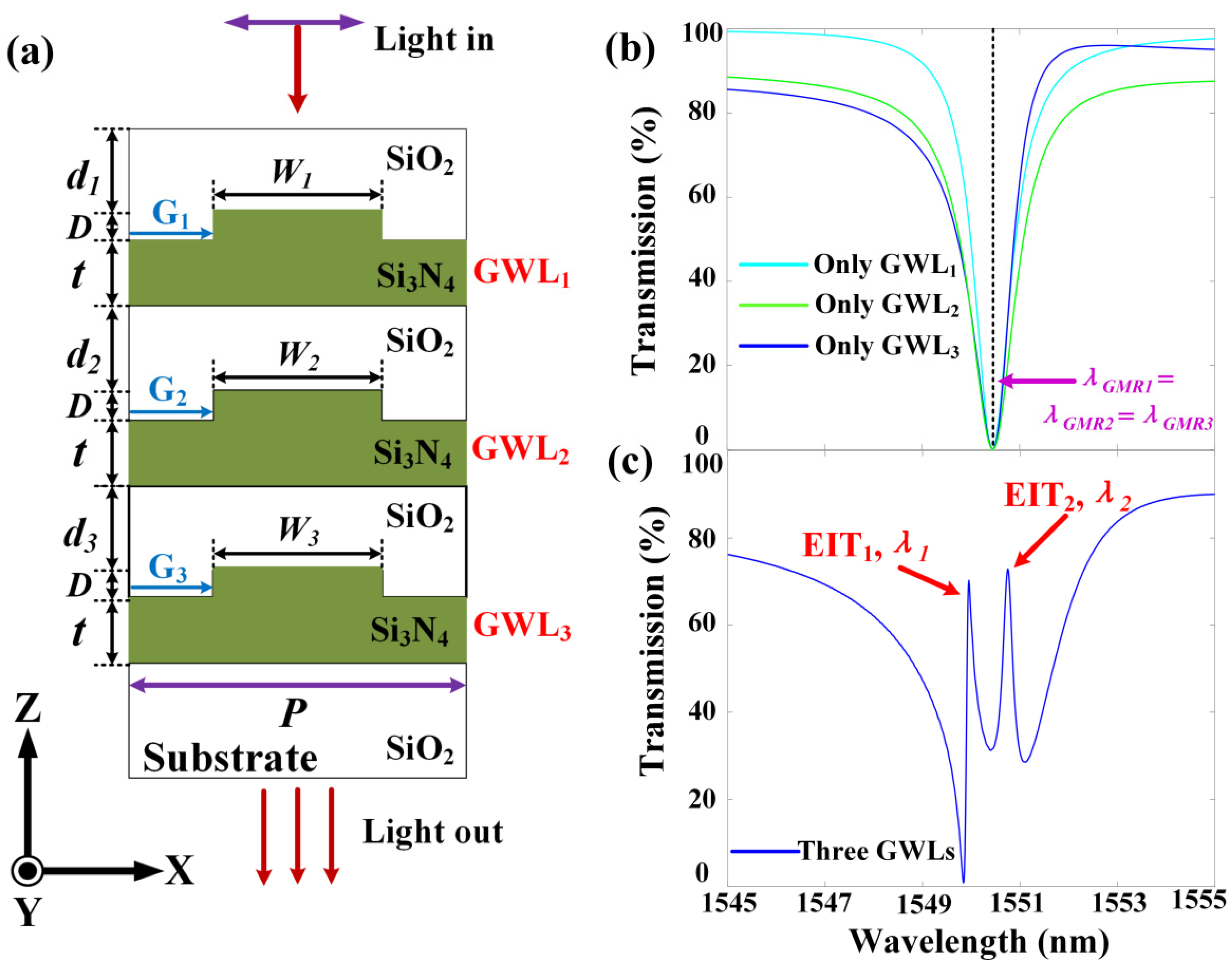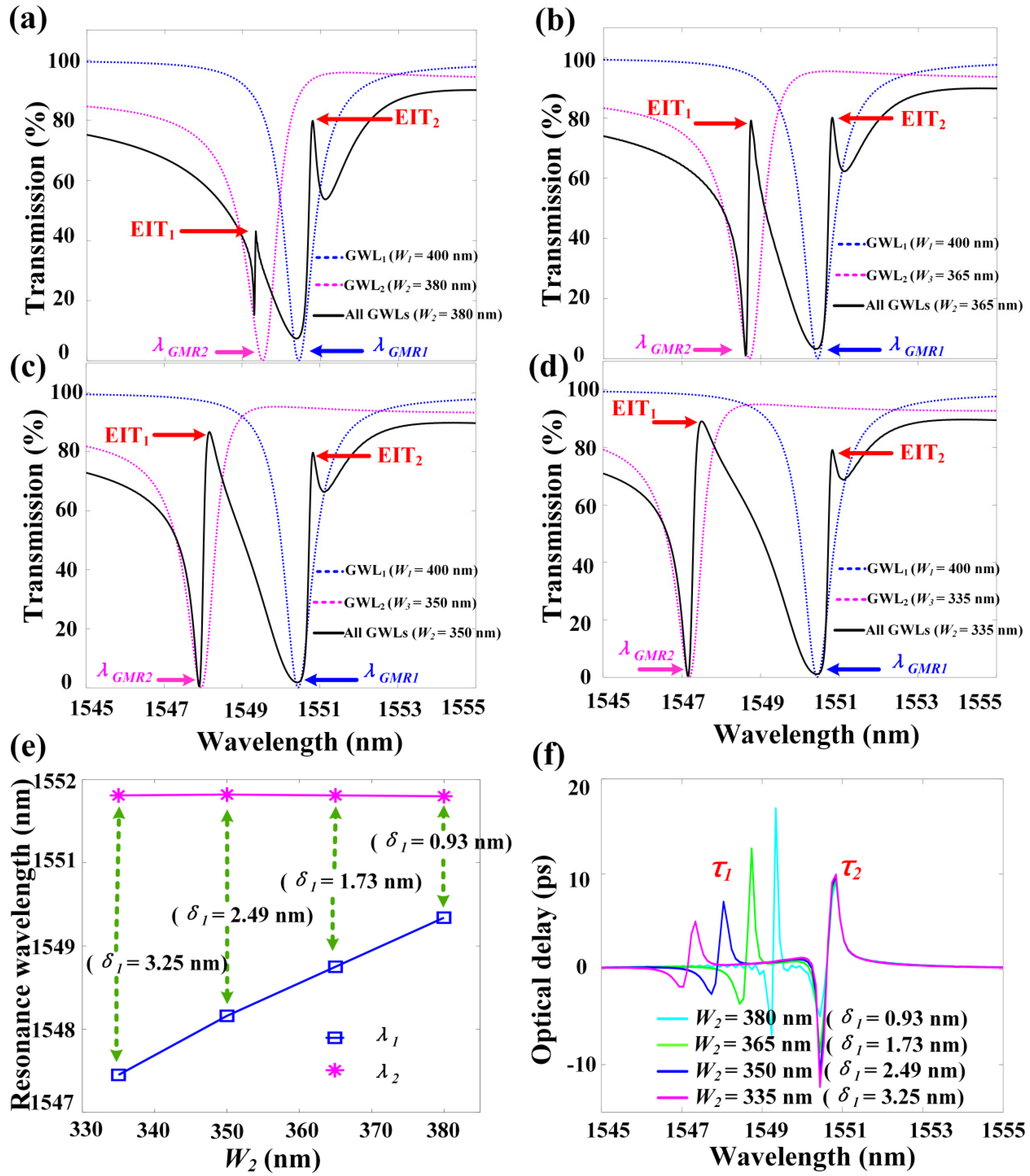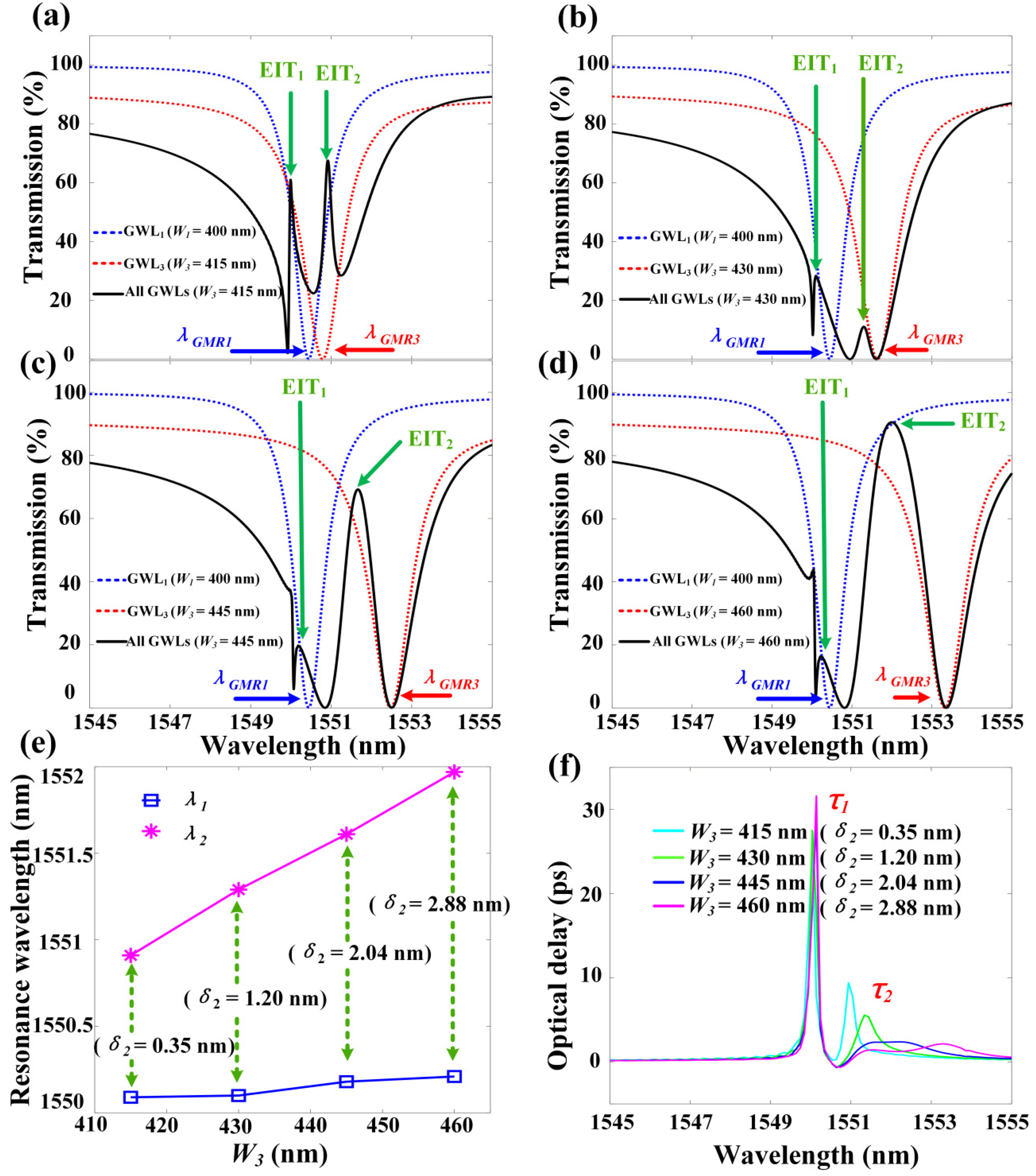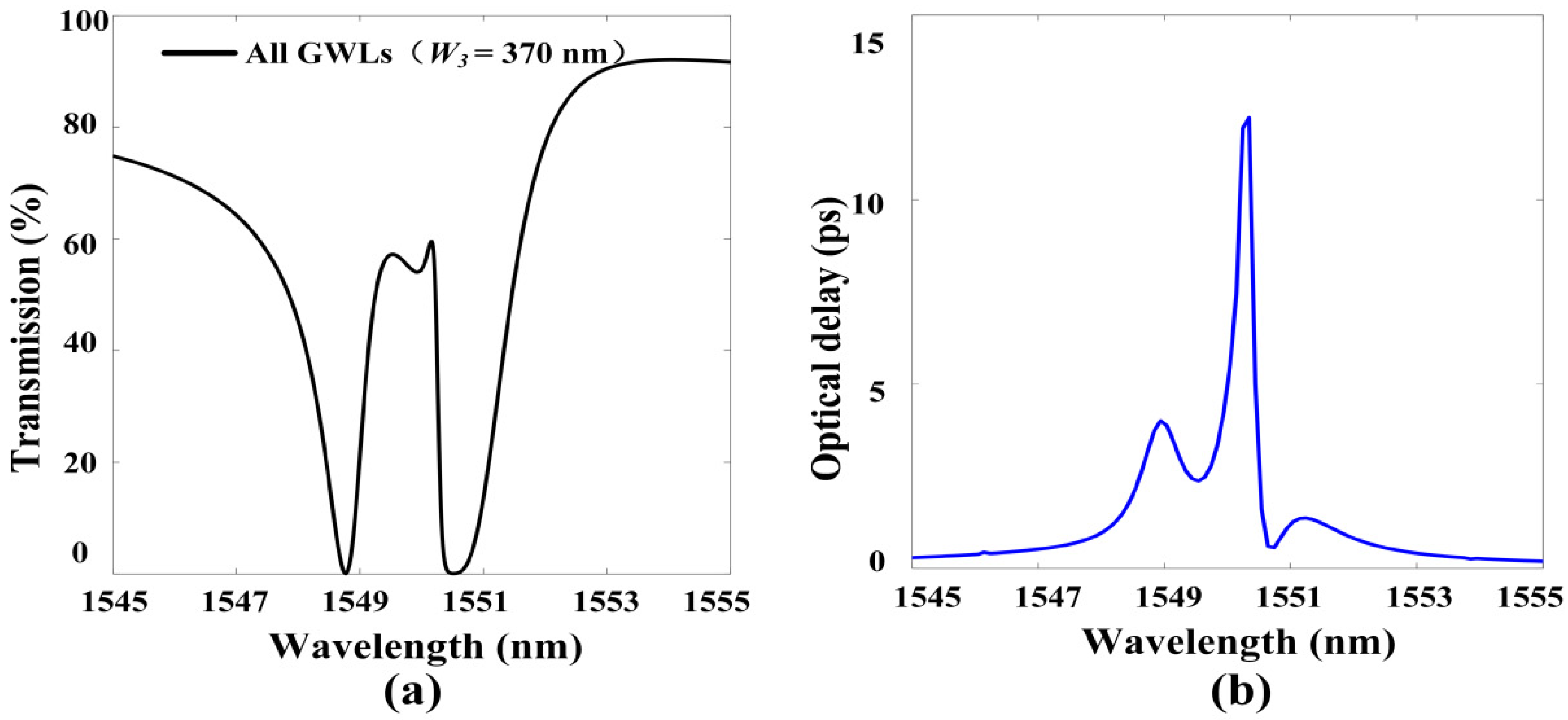Double Electromagnetically Induced Transparency and Its Slow Light Application Based on a Guided-Mode Resonance Grating Cascade Structure
Abstract
:1. Introduction
2. Materials and Methods
3. Results
4. Discussion
5. Conclusions
Author Contributions
Funding
Conflicts of Interest
References
- Kocharovskaya, A.; Khanin, Y.I. Population trapping and coherent bleaching of a three-level medium by a periodic train of ultrashort pulses. Zh. Eksp. Teor. Fiz 1986, 90, 1610–1618. [Google Scholar]
- Harris, S.E.; Yin, G.Y.; Kasapi, A.; Jain, M.; Luo, Z.F. Electromagnetically induced transparency. In Coherence and Quantum Optics VII; Springer: Boston, MA, USA, 1997; pp. 295–304. [Google Scholar] [CrossRef]
- Strelniker, Y.M.; Bergman, D. Transmittance and transparency of subwavelength-perforated conducting films in the presence of a magnetic field. Phys. Rev. B 2008, 77, 205113. [Google Scholar] [CrossRef] [Green Version]
- Hau, L.V.; Harris, S.E.; Dutton, Z.; Behroozi, C.H. Light speed reduction to 17 metres per second in an ultracold atomic gas. Nature 1999, 397, 594–598. [Google Scholar] [CrossRef]
- Khurgin, J.B.; Tucker, R.S. Slow Light: Science and Applications, 1st ed.; CRC Press: Boca Raton, FL, USA, 2008. [Google Scholar]
- Huang, Y.; Min, C.; Veronis, G. Subwavelength slow-light waveguides based on a plasmonic analogue of electromagnetically induced transparency. Appl. Phys. Lett. 2011, 99, 143117. [Google Scholar] [CrossRef] [Green Version]
- Wei, Z.; Li, X.; Zhong, N.; Tan, X.; Zhang, X.; Liu, H.; Meng, H.; Liang, R. Analogue Electromagnetically Induced Transparency Based on Low-loss Metamaterial and its Application in Nanosensor and Slow-light Device. Plasmonics 2017, 12, 641–647. [Google Scholar] [CrossRef]
- Ilchenko, V.S.; Savchenkov, A.A.; Matsko, A.B.; Maleki, L. Nonlinear optics and crystalline whispering gallery mode cavities. Phys. Rev. Lett. 2004, 92, 043903. [Google Scholar] [CrossRef]
- Xiao, Y.F.; Özdemir, Ş.K.; Gaddam, V.; Dong, C.H.; Imoto, N.; Yang, L. Quantum nondemolition measurement of photon number via optical Kerr effect in an ultra-high-Q microtoroid cavity. Opt. Express 2008, 16, 21462–21475. [Google Scholar] [CrossRef]
- Fan, S. Sharp asymmetric line shapes in side-coupled waveguide-cavity systems. Appl. Phys. Lett. 2002, 80, 908–910. [Google Scholar] [CrossRef] [Green Version]
- Chao, C.Y.; Guo, L.J. Biochemical sensors based on polymer microrings with sharp asymmetrical resonance. Appl. Phys. Lett. 2003, 83, 1527–1529. [Google Scholar] [CrossRef]
- Xiao, Y.F.; He, L.; Zhu, J.; Yang, L. Electromagnetically induced transparency-like effect in a single polydimethylsiloxane-coated silica microtoroid. Appl. Phys. Lett. 2009, 94, 231115. [Google Scholar] [CrossRef]
- Shvets, G.; Wurtele, J.S. Transparency of magnetized plasma at the cyclotron frequency. Phys. Rev. Lett. 2002, 89, 115003. [Google Scholar] [CrossRef] [PubMed] [Green Version]
- Liu, N.; Langguth, L.; Weiss, T.; Kästel, J.; Fleischhauer, M.; Pfau, T.; Giessen, H. Plasmonic analogue of electromagnetically induced transparency at the Drude damping limit. Nature Mater. 2009, 8, 758–762. [Google Scholar] [CrossRef] [PubMed]
- Singh, R.; Rockstuhl, C.; Lederer, F.; Zhang, W. Coupling between a dark and a bright eigenmode in a terahertz metamaterial. Phys. Rev. B 2009, 79, 085111. [Google Scholar] [CrossRef] [Green Version]
- Zhang, J.; Xiao, S.; Jeppesen, C.; Kristensen, A.; Mortensen, N.A. Electromagnetically induced transparency in metamaterials at near-infrared frequency. Opt. Express 2010, 18, 17187–17192. [Google Scholar] [CrossRef] [Green Version]
- Lee, S.G.; Jung, S.Y.; Kim, H.S.; Lee, S.; Park, J.M. Electromagnetically induced transparency based on guided-mode resonances. Opt. Lett. 2015, 40, 4241–4244. [Google Scholar] [CrossRef] [PubMed]
- Lee, S.G.; Kim, S.H.; Kim, K.J.; Kee, C.S. Polarization-independent electromagnetically induced transparency-like transmission in coupled guided-mode resonance structures. Appl. Phys. Lett. 2017, 110, 111106. [Google Scholar] [CrossRef]
- Sun, Y.; Chen, H.; Li, X.; Hong, Z. Electromagnetically induced transparency in planar metamaterials based on guided mode resonance. Opt. Commun. 2017, 392, 142–146. [Google Scholar] [CrossRef]
- Han, Y.; Yang, J.; He, X.; Huang, J.; Zhang, J.; Chen, D.; Zhang, Z. High quality factor electromagnetically induced transparency-like effect in coupled guided-mode resonant systems. Opt. Express 2019, 27, 7712–7718. [Google Scholar] [CrossRef]
- Li, G.; Yang, J.; Zhang, Z.; Wen, K.; Tao, Y.; Han, Y.; Zhang, Z. Double Spectral Electromagnetically Induced Transparency Based on Double-Bar Dielectric Grating and Its Sensor Application. Appl. Sci. 2020, 10, 3033. [Google Scholar] [CrossRef]
- Ko, Y.H.; Magnusson, R. Flat-top bandpass filters enabled by cascaded resonant gratings. Opt. Lett. 2016, 41, 4704–4707. [Google Scholar] [CrossRef]
- Yamada, K.; Lee, K.J.; Ko, Y.H.; Inoue, J.; Kintaka, K.; Ura, H.; Magnusson, R. Flat-top narrowband filters enabled by guided-mode resonance in two-level waveguides. Opt. Lett. 2017, 42, 4127–4130. [Google Scholar] [CrossRef] [PubMed]
- Doskolovich, L.L.; Bezus, E.A.; Bykov, D.A. Integrated flat-top reflection filters operating near bound states in the continuum. Photon. Res. 2019, 7, 1314–1322. [Google Scholar] [CrossRef] [Green Version]
- Doskolovich, L.L.; Bezus, E.A.; Bykov, D.A.; Golovastikov, N.V.; Soifer, V.A. Resonant properties of composite structures consisting of several resonant diffraction gratings. Opt. Express 2019, 27, 25814–25828. [Google Scholar] [CrossRef] [PubMed]
- Chen, J.; Chu, P. Phase-induced Fano antiresonance in a planar waveguide with two dielectric ridges. J. Opt. Soc. Am. B 2019, 36, 3417–3427. [Google Scholar] [CrossRef]
- Malitson, I.H. Interspecimen comparison of the refractive index of fused silica. J. Opt. Soc. Am. 1965, 55, 1205–1209. [Google Scholar] [CrossRef]
- Kischkat, J.; Peters, S.; Gruska, B.; Semtsiv, M.; Chashnikova, M.; Klinkmüller, M.; Fedosenko, O.; Machulik, S.; Aleksandrova, A.; Monastyrskyi, G.; et al. Mid-infrared optical properties of thin films of aluminum oxide, titanium dioxide, silicon dioxide, aluminum nitride, and silicon nitride. Appl. Opt. 2012, 51, 6789–6798. [Google Scholar] [CrossRef]
- Papasimakis, N.; Fedotov, V.A.; Zheludev, N.I.; Prosvirnin, S.L. Metamaterial analog of electromagnetically induced transparency. Phys. Rev. Lett. 2008, 101, 253903. [Google Scholar] [CrossRef] [Green Version]
- Kekatpure, R.D.; Barnard, E.S.; Cai, W.; Brongersma, M.L. Phase-coupled plasmon-induced transparency. Phys. Rev. Lett. 2010, 104, 243902. [Google Scholar] [CrossRef]
- Fleischhauer, M.; Imamoglu, A.; Marangos, J.P. Electromagnetically induced transparency: Optics in coherent media. Rev. Mod. Phys. 2005, 77, 633. [Google Scholar] [CrossRef] [Green Version]
- Liu, Y.C.; Li, B.B.; Xiao, Y.F. Electromagnetically induced transparency in optical microcavities. Nanophotonics 2017, 6, 789–811. [Google Scholar] [CrossRef]
- Bigelow, M.S.; Lepeshkin, N.N.; Boyd, R.W. Superluminal and slow light propagation in a room-temperature solid. Science 2003, 301, 200–202. [Google Scholar] [CrossRef] [PubMed] [Green Version]
- Zhang, Z.; Yang, J.; He, X.; Han, Y.; Zhang, J.; Huang, J.; Chen, D.; Xu, S. Active enhancement of slow light based on plasmon-induced transparency with gain materials. Materials 2018, 11, 941. [Google Scholar] [CrossRef] [PubMed] [Green Version]
- Magnusson, R.; Shokooh-Saremi, M.; Wang, X. Dispersion engineering with leaky-mode resonant photonic lattices. Opt. Express 2010, 18, 108–116. [Google Scholar] [CrossRef]
- Chen, Y.; Zhang, Z.; Yu, M. Tunable out-of-plane slow light in resonance induced transparent grating waveguide structures. Appl. Phys. Lett. 2013, 103, 061109. [Google Scholar] [CrossRef]
- Tang, B.; Dai, L.; Jiang, C. Transmission enhancement of slow light by a subwavelength plasmon-dielectric system. J. Opt. Soc. Am. B 2010, 27, 2433–2437. [Google Scholar] [CrossRef]






| Reference | τ1 (ps) | τ2 (ps) |
|---|---|---|
| this work | 22.59 | 8.43 |
| 35 | 29.73 | – |
| 36 | 21.80 | – |
| 37 | 3.10 | – |
© 2020 by the authors. Licensee MDPI, Basel, Switzerland. This article is an open access article distributed under the terms and conditions of the Creative Commons Attribution (CC BY) license (http://creativecommons.org/licenses/by/4.0/).
Share and Cite
Li, G.; Yang, J.; Zhang, Z.; Tao, Y.; Zhou, L.; Huang, H.; Zhang, Z.; Han, Y. Double Electromagnetically Induced Transparency and Its Slow Light Application Based on a Guided-Mode Resonance Grating Cascade Structure. Materials 2020, 13, 3710. https://doi.org/10.3390/ma13173710
Li G, Yang J, Zhang Z, Tao Y, Zhou L, Huang H, Zhang Z, Han Y. Double Electromagnetically Induced Transparency and Its Slow Light Application Based on a Guided-Mode Resonance Grating Cascade Structure. Materials. 2020; 13(17):3710. https://doi.org/10.3390/ma13173710
Chicago/Turabian StyleLi, Guofeng, Junbo Yang, Zhaojian Zhang, Yuyu Tao, Lingjun Zhou, Huimin Huang, Zhenrong Zhang, and Yunxin Han. 2020. "Double Electromagnetically Induced Transparency and Its Slow Light Application Based on a Guided-Mode Resonance Grating Cascade Structure" Materials 13, no. 17: 3710. https://doi.org/10.3390/ma13173710






